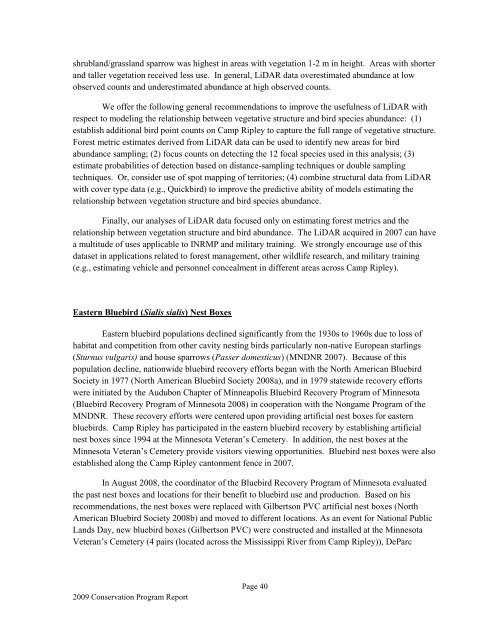camp ripley and arden hills minnesota army national guard training ...
camp ripley and arden hills minnesota army national guard training ...
camp ripley and arden hills minnesota army national guard training ...
You also want an ePaper? Increase the reach of your titles
YUMPU automatically turns print PDFs into web optimized ePapers that Google loves.
shrubl<strong>and</strong>/grassl<strong>and</strong> sparrow was highest in areas with vegetation 1-2 m in height. Areas with shorter<br />
<strong>and</strong> taller vegetation received less use. In general, LiDAR data overestimated abundance at low<br />
observed counts <strong>and</strong> underestimated abundance at high observed counts.<br />
We offer the following general recommendations to improve the usefulness of LiDAR with<br />
respect to modeling the relationship between vegetative structure <strong>and</strong> bird species abundance: (1)<br />
establish additional bird point counts on Camp Ripley to capture the full range of vegetative structure.<br />
Forest metric estimates derived from LiDAR data can be used to identify new areas for bird<br />
abundance sampling; (2) focus counts on detecting the 12 focal species used in this analysis; (3)<br />
estimate probabilities of detection based on distance-sampling techniques or double sampling<br />
techniques. Or, consider use of spot mapping of territories; (4) combine structural data from LiDAR<br />
with cover type data (e.g., Quickbird) to improve the predictive ability of models estimating the<br />
relationship between vegetation structure <strong>and</strong> bird species abundance.<br />
Finally, our analyses of LiDAR data focused only on estimating forest metrics <strong>and</strong> the<br />
relationship between vegetation structure <strong>and</strong> bird abundance. The LiDAR acquired in 2007 can have<br />
a multitude of uses applicable to INRMP <strong>and</strong> military <strong>training</strong>. We strongly encourage use of this<br />
dataset in applications related to forest management, other wildlife research, <strong>and</strong> military <strong>training</strong><br />
(e.g., estimating vehicle <strong>and</strong> personnel concealment in different areas across Camp Ripley).<br />
Eastern Bluebird (Sialis sialis) Nest Boxes<br />
Eastern bluebird populations declined significantly from the 1930s to 1960s due to loss of<br />
habitat <strong>and</strong> competition from other cavity nesting birds particularly non-native European starlings<br />
(Sturnus vulgaris) <strong>and</strong> house sparrows (Passer domesticus) (MNDNR 2007). Because of this<br />
population decline, nationwide bluebird recovery efforts began with the North American Bluebird<br />
Society in 1977 (North American Bluebird Society 2008a), <strong>and</strong> in 1979 statewide recovery efforts<br />
were initiated by the Audubon Chapter of Minneapolis Bluebird Recovery Program of Minnesota<br />
(Bluebird Recovery Program of Minnesota 2008) in cooperation with the Nongame Program of the<br />
MNDNR. These recovery efforts were centered upon providing artificial nest boxes for eastern<br />
bluebirds. Camp Ripley has participated in the eastern bluebird recovery by establishing artificial<br />
nest boxes since 1994 at the Minnesota Veteran‟s Cemetery. In addition, the nest boxes at the<br />
Minnesota Veteran‟s Cemetery provide visitors viewing opportunities. Bluebird nest boxes were also<br />
established along the Camp Ripley cantonment fence in 2007.<br />
In August 2008, the coordinator of the Bluebird Recovery Program of Minnesota evaluated<br />
the past nest boxes <strong>and</strong> locations for their benefit to bluebird use <strong>and</strong> production. Based on his<br />
recommendations, the nest boxes were replaced with Gilbertson PVC artificial nest boxes (North<br />
American Bluebird Society 2008b) <strong>and</strong> moved to different locations. As an event for National Public<br />
L<strong>and</strong>s Day, new bluebird boxes (Gilbertson PVC) were constructed <strong>and</strong> installed at the Minnesota<br />
Veteran‟s Cemetery (4 pairs (located across the Mississippi River from Camp Ripley)), DeParc<br />
2009 Conservation Program Report<br />
Page 40
















